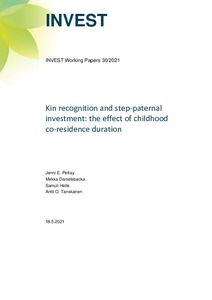Kin recognition and step-paternal investment: the effect of childhood co-residence duration
Helle Samuli; Danielsbacka Mirkka; Pettay Jenni; Tanskanen Antti O.
https://urn.fi/URN:NBN:fi-fe2022012811245
Tiivistelmä
Evolutionarily relevant nepotistic kin investment requires reliable kin detection. Evolutionary scholars have argued that childhood co-residence is one of the most important indirect cues for kinship. While childhood co-residence duration has been found to correlate with kin investment in intragenerational studies (i.e., among siblings), intergenerational investigations considering the association between childhood co-residence duration and kin investment have been scarce. Here, we investigate whether the investment of biological and stepfathers is correlated with childhood co-residence duration. We used data from adolescents and adults (aged 17–19, 27–29, and 37–39 years) from the German Panel Analysis of Intimate Relationships and Family Dynamics (Pairfam), wave 2, collected in 2010–2011. Paternal investment was measured as financial and practical help, emotional support, intimacy, and emotional closeness. We found that while stepfathers invested less than biological fathers, both biological and stepfathers’ investments increased with increased childhood co-residence duration in most measures. Financial help correlated with childhood co-residence in stepfathers but not in biological fathers who helped financially more than stepfathers regardless of childhood co-residence duration. Emotional support, intimacy, and emotional closeness were correlated with childhood co-residence in both biological fathers and stepfathers. Practical help did not correlate with co-residence in either father. Thus, our results partially support the hypothesis that childhood co-residence duration serves as a kin detection cue and directs intergenerational altruism.
Kokoelmat
- Rinnakkaistallenteet [19204]
